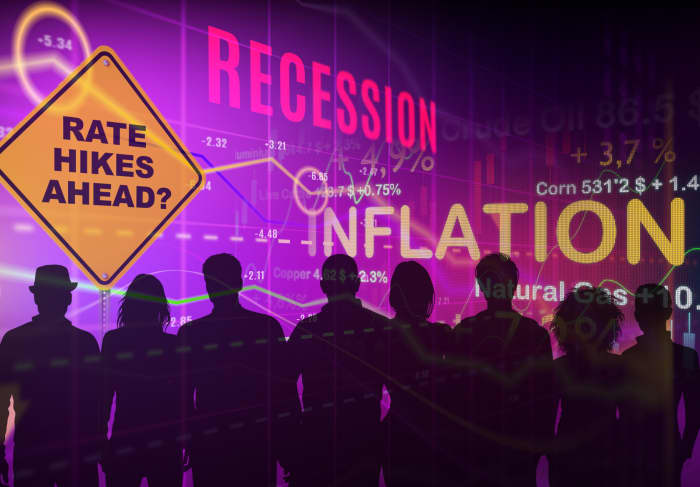The bond market hasn’t been this popular for over a decade.
For almost 15 years after the financial crisis of 2008, bond yields remained low and the U.S. stock market was much more appealing.
That’s no longer the case.
Treasury bills
TMUBMUSD01Y,
As risk-free returns have gone up as the Federal Reserve has raised interest rates, some have argued that the risks of owning U.S. stocks today may outweigh the rewards.
Still, concerns about the financial markets’ reaction after a U.S. debt ceiling deal, uncertainty about whether the Fed is done with interest rate hikes, and a potential recession are complicating the picture.
Read: A debt-ceiling deal will spark a new worry: Who will buy the deluge of Treasury bills?
President Joe Biden and House Speaker Kevin McCarthy late Saturday reached an “agreement in principle” to raise U.S.’s debt ceiling, which if passed by the House and Senate later this week, will stave off a historic default that could shake the global financial markets.
McCarthy reportedly said he would talk to Biden again on Sunday and line the bill up for a vote on Wednesday, according to a Bloomberg article. There is now very little room for error, as Treasury Secretary Janet Yellen warned that an extension must be finalized by June 5 to avoid a default of U.S. federal debt. Worries around the debt ceiling sent Treasury yields maturing in the first eight days of June briefly to top 7% during the past week.
While a deal is now in place, Mike Boroughs, managing partner of Fortis Financial Group, a wealth management firm, said from the risk management perspective, he wouldn’t recommend clients betting on the very short-term Treasurys.
Still, his company has shifted more of their client assets into bonds in the last six to nine months as interest rates have gone up. He has been mostly eyeing Treasurys with maturities of six to 12 months.
“Because there are a lot of great opportunities now, particularly for older folks who just need a fixed return and are not looking for huge growth,” Boroughs said in a phone interview.
Richard Flax, chief investment officer at Moneyfarm, said he prefers bonds with duration less than five years, “given how flat we think yield curves are and given all of the uncertainty about what central banks may need to do with inflation that continues to be stickier than we might have hoped”.
The PCE index, which is the Fed’s preferred inflation barometer, rose 0.4% in April and the yearly increase in prices rose to 4.4% from 4.2% in the prior month.
Following the release of the data on Friday, traders are pricing in a higher chance that the Fed will deliver another rate hike in June.
Fed fund futures traders now see a 70% likelihood that Fed will raise its key interest rate by 25 basis point in its next meeting. That’s up from 51.7% a day ago according to the CME FedWatch Tool.
Flax added that his company is conservatively positioned on equities, but not as conservative as they were last year.
As bond yields went up, some of the pressure has already been reflected in equity valuations, Flax. “And we need to think about how much of it is priced in,” Flax said.
“It becomes a question of, what do you think are the outlook for corporate earnings and cash flow stream? What’s the potential growth in that over the next X number of years? And how much you’ve been asked to pay for that potential stream of earnings or potential stream of cash flow? Is that attractive or not?” Flax said.
The balance between stocks and bonds also depends on where investors think the equilibrium Fed funds rate stands, according to Phillip Colmar, Partner and Global Strategist at MRB Partners. The equilibrium Fed funds rate is the short-term interest rate consistent with full employment and stable inflation in the long run.
If an investor expects the equilibrium Fed funds rates to stand at around 2.5%, which would mean that over the long run the Fed’s policy rates will be much lower than they are today, then the current bond yields would be attractive, Colmar said. The Fed fund rate is currently 5% to 5.25%.
However, Colmar said he doesn’t see that as the case. Structural inflation has tilted up, and both the equilibrium Fed funds rates and inflation could stay higher, Colmar said. “On a 10-year basis, you might not yield very much in real yields. And you might even lose a little bit of purchasing power, flat at best,” Colmar noted via phone.
“It may be a protection spot in the middle of the downturn, but you’re not preserving wealth or at least accumulating wealth in real terms, inflation adjusted terms in this kind of environment,” noted Colmar.
Colmar added that he is underweight in bonds, neutral in equities and overweight in cash.
A group of analysts at JPMorgan led by Marko Kolanovic also prefer cash over stocks.
“Even aside from the debt ceiling issue, we maintain that the risk-reward for equities is poor given elevated risk of recession, stretched valuations, high rates and tightening liquidity, and we favor cash over equities at the former’s ~5% yields,” the analysts wrote in a Thursday note.
This month the analysts raised the cash allocation in their model portfolio by 2%, funded by reducing their weighting to equities and corporate bonds by one percentage point each, the analysts said.
Nevertheless, David Sekera, chief U.S. market strategist for Morningstar Research Services, said he thinks the U.S. stock market is still 8% undervalued compared to the company’s long term intrinsic valuations.
“Having said that, I do think that the market is facing a rough road ahead for the next couple of quarters. And that’s really based on our economic outlook for relatively stagnant growth,” Sekera said.
At the beginning of the year, Sekera said they were overweight in value and growth stocks, and underweight in core stocks. For now, the company has moved to a market weight to growth stocks and retained the previous weight in value and core stocks.
Sekera also said they are overweight in small-cap stocks. “We do think that small cap stocks still have much further to run, especially once the leading economic indicators turn around,” according to Sekera.
Major stock indexes ended the week most higher. The Dow Jones Industrial Average
DJIA,
Next week, investors will be waiting for the consumer confidence data due Tuesday, the ADP private sector employment data due Wednesday, the ISM manufacturing sector activity index due Thursday and most importantly, the U.S. employment report to be released on Friday.







